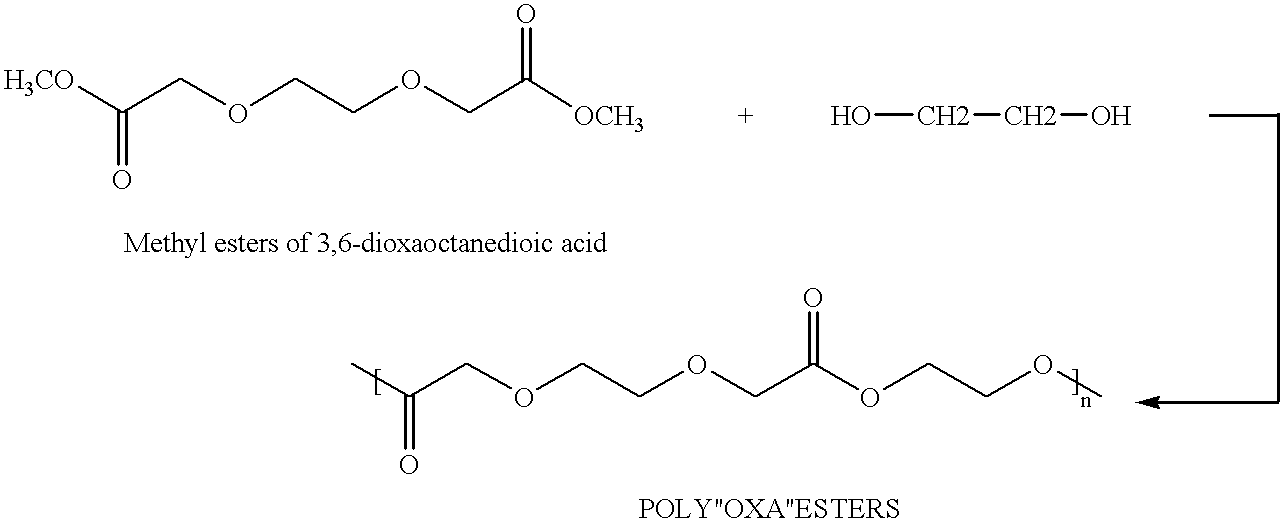Method of preventing adhesions with absorbable polyoxaesters
a polyoxaester and absorbable technology, applied in the field of preventing adhesions with absorbable polyoxaesters, can solve the problems of not meeting the needs of the medical community, less research has been reported on aliphatic polyesters, and polylactones do not readily transmit water vapor, so as to prevent adhesion formation and prevent adhesion formation
- Summary
- Abstract
- Description
- Claims
- Application Information
AI Technical Summary
Benefits of technology
Problems solved by technology
Method used
Image
Examples
example 1
Preparation of 3,6-Dioxaoctanedioic acid dimethylester
[0087]
[0088]The diacid, 3,6-dioxaoctanedioic acid, was synthesized by oxidation of triethylene glycol. The oxidation was carried out in a 500 milliliter, three-neck round bottom flask equipped with a thermometer, an additional funnel, a gas absorption tube and a magnetic spinbar. The reaction flask was lowered into an oil bath resting upon a magnetic stirrer. To the reaction flask was added 157.3 ml of a 60% nitric acid solution; 37.0 g of triethylene glycol was added to the additional funnel. The contents of the flask were heated to 78-80° C. A test tube containing 0.5 g of glycol and one milliliter of concentrated nitric acid was warmed in a water bath until brown fumes started appearing. The contents were then added to the reaction flask. The mixture was stirred for a few minutes; the glycol was then carefully added. The rate of addition had to be monitored extremely carefully to keep the reaction under control. The addition r...
example 2
Preparation of polyoxaester from the methyl esters of 3,6-dioxaoctanedioic acid and ethylene glycol
[0091]
[0092]A flame dried, mechanically stirred, 50-milliliter glass reactor suitable for polycondensation reaction, was charged with 20.62 g (approximately 0.1 mole) of the methyl esters of 3,6-dioxaoctanedioic acid from Example 1, 18.62 g (0.3 mole) of distilled ethylene glycol, and 0.0606 ml of a solution of 0.33M stannous octoate in toluene. After purging the reactor and venting with nitrogen, the temperature was gradually raised over the course of 26 hours to 180° C. A temperature of 180° C. was then maintained for another 20 hours; all during these heating periods under nitrogen at one atmosphere, the methanol formed was collected. The reaction flask was allowed to cool to room temperature; it was then slowly heated under reduced pressure (0.015-1.0 mm) over the course of about 32 hours to 160° C., during which time additional distillates were collected. A temperature of 160° C. ...
example 3
Preparation of polyoxaester with 3,6,9-trioxaundecanedioic acid and ethylene glycol
[0093]A flame dried, mechanically stirred, 250-milliliter glass reactor, suitable for polycondensation reaction, was charged with 44.44 g (0.2 mole) of 3,6,9-trioxaundecanedioic acid, 62.07 g (1.0 mole) of distilled ethylene glycol, and 9.96 milligrams of dibutyltin oxide. After purging the reactor and venting with nitrogen, the contents of the reaction flask were gradually heated
under nitrogen at one atmosphere, in the course of about 32 hours, to 180° C., during which time the water formed was collected. The reaction mass was allowed to cool to room temperature. The reaction mass was then heated under reduced pressure (0.015-1.0 mm), gradually increasing the temperature to 180° C. in about 40 hours; during this time additional distillates were collected. The polymerization was continued under reduced pressure while maintaining 180° C. for an additional 16 hours. The resulting polymer has an inheren...
PUM
| Property | Measurement | Unit |
|---|---|---|
| temperature | aaaaa | aaaaa |
| temperature | aaaaa | aaaaa |
| weight percent | aaaaa | aaaaa |
Abstract
Description
Claims
Application Information
 Login to View More
Login to View More - R&D
- Intellectual Property
- Life Sciences
- Materials
- Tech Scout
- Unparalleled Data Quality
- Higher Quality Content
- 60% Fewer Hallucinations
Browse by: Latest US Patents, China's latest patents, Technical Efficacy Thesaurus, Application Domain, Technology Topic, Popular Technical Reports.
© 2025 PatSnap. All rights reserved.Legal|Privacy policy|Modern Slavery Act Transparency Statement|Sitemap|About US| Contact US: help@patsnap.com



